Economic Report: Demand and Supply Dynamics of Nurses in Australia
VerifiedAdded on 2020/05/28
|6
|1045
|68
Report
AI Summary
This report delves into the microeconomic analysis of the demand and supply of nurses in Australia. It highlights the increasing demand for nurses due to a growing population and expanding healthcare services, while also addressing the challenges in maintaining a steady supply. The report examine...
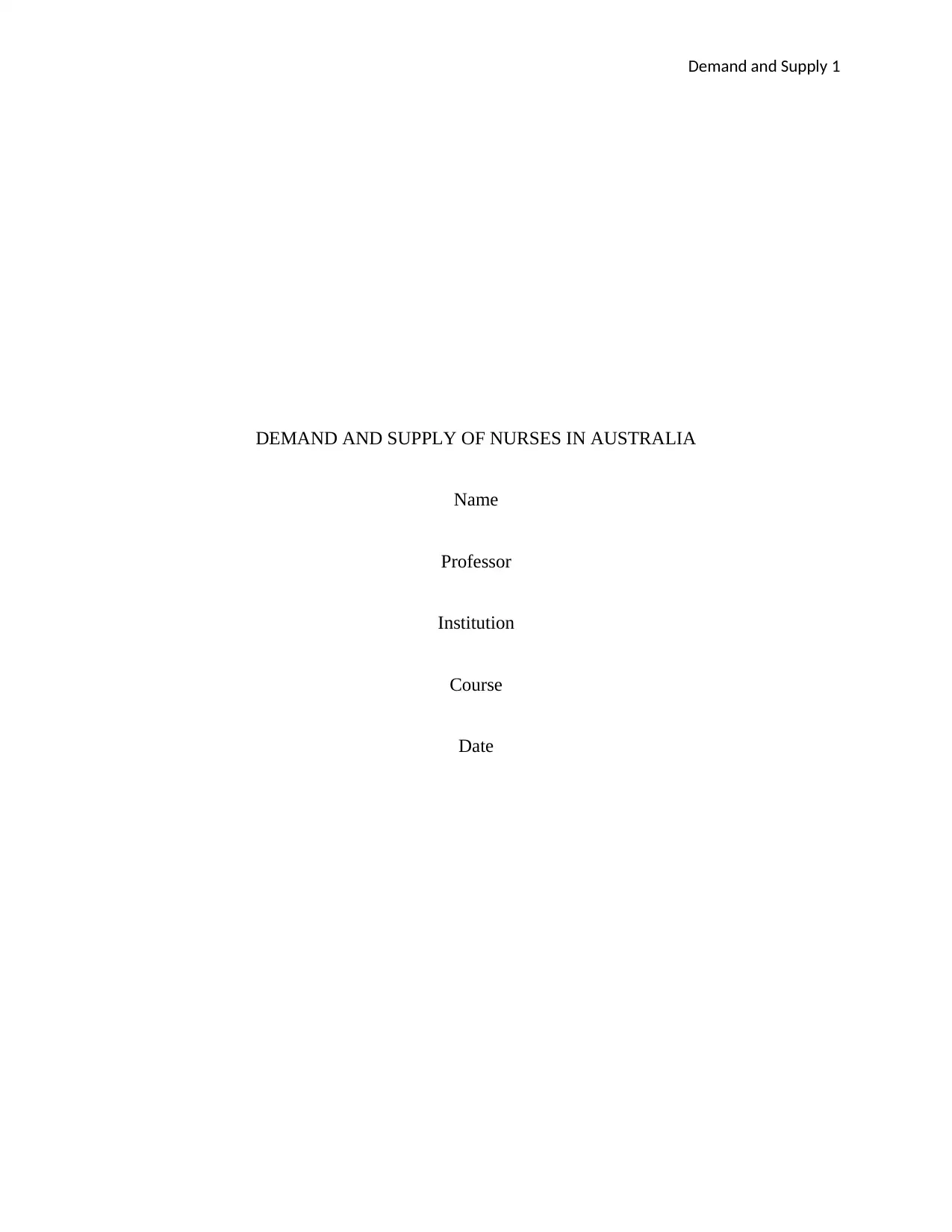
Demand and Supply 1
DEMAND AND SUPPLY OF NURSES IN AUSTRALIA
Name
Professor
Institution
Course
Date
DEMAND AND SUPPLY OF NURSES IN AUSTRALIA
Name
Professor
Institution
Course
Date
Secure Best Marks with AI Grader
Need help grading? Try our AI Grader for instant feedback on your assignments.
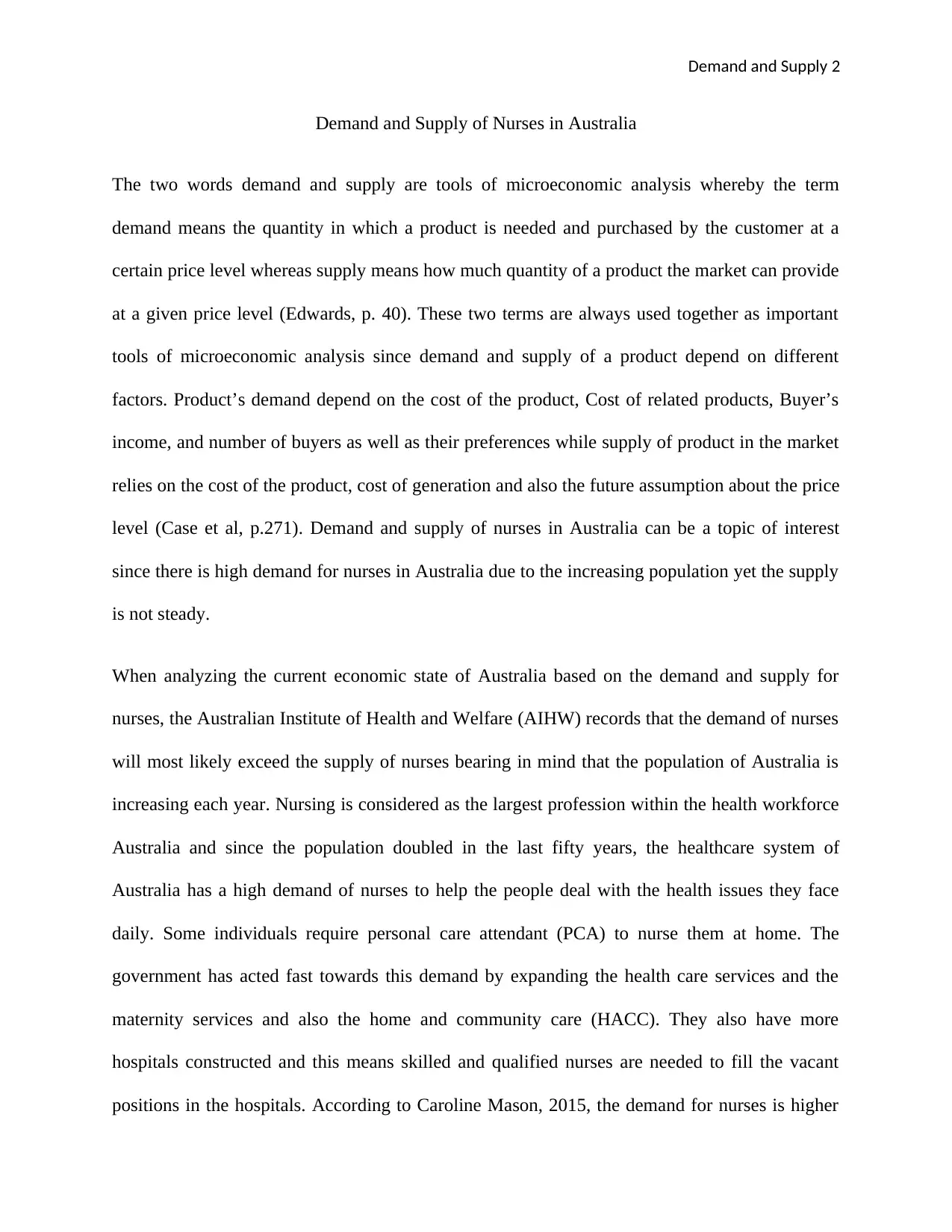
Demand and Supply 2
Demand and Supply of Nurses in Australia
The two words demand and supply are tools of microeconomic analysis whereby the term
demand means the quantity in which a product is needed and purchased by the customer at a
certain price level whereas supply means how much quantity of a product the market can provide
at a given price level (Edwards, p. 40). These two terms are always used together as important
tools of microeconomic analysis since demand and supply of a product depend on different
factors. Product’s demand depend on the cost of the product, Cost of related products, Buyer’s
income, and number of buyers as well as their preferences while supply of product in the market
relies on the cost of the product, cost of generation and also the future assumption about the price
level (Case et al, p.271). Demand and supply of nurses in Australia can be a topic of interest
since there is high demand for nurses in Australia due to the increasing population yet the supply
is not steady.
When analyzing the current economic state of Australia based on the demand and supply for
nurses, the Australian Institute of Health and Welfare (AIHW) records that the demand of nurses
will most likely exceed the supply of nurses bearing in mind that the population of Australia is
increasing each year. Nursing is considered as the largest profession within the health workforce
Australia and since the population doubled in the last fifty years, the healthcare system of
Australia has a high demand of nurses to help the people deal with the health issues they face
daily. Some individuals require personal care attendant (PCA) to nurse them at home. The
government has acted fast towards this demand by expanding the health care services and the
maternity services and also the home and community care (HACC). They also have more
hospitals constructed and this means skilled and qualified nurses are needed to fill the vacant
positions in the hospitals. According to Caroline Mason, 2015, the demand for nurses is higher
Demand and Supply of Nurses in Australia
The two words demand and supply are tools of microeconomic analysis whereby the term
demand means the quantity in which a product is needed and purchased by the customer at a
certain price level whereas supply means how much quantity of a product the market can provide
at a given price level (Edwards, p. 40). These two terms are always used together as important
tools of microeconomic analysis since demand and supply of a product depend on different
factors. Product’s demand depend on the cost of the product, Cost of related products, Buyer’s
income, and number of buyers as well as their preferences while supply of product in the market
relies on the cost of the product, cost of generation and also the future assumption about the price
level (Case et al, p.271). Demand and supply of nurses in Australia can be a topic of interest
since there is high demand for nurses in Australia due to the increasing population yet the supply
is not steady.
When analyzing the current economic state of Australia based on the demand and supply for
nurses, the Australian Institute of Health and Welfare (AIHW) records that the demand of nurses
will most likely exceed the supply of nurses bearing in mind that the population of Australia is
increasing each year. Nursing is considered as the largest profession within the health workforce
Australia and since the population doubled in the last fifty years, the healthcare system of
Australia has a high demand of nurses to help the people deal with the health issues they face
daily. Some individuals require personal care attendant (PCA) to nurse them at home. The
government has acted fast towards this demand by expanding the health care services and the
maternity services and also the home and community care (HACC). They also have more
hospitals constructed and this means skilled and qualified nurses are needed to fill the vacant
positions in the hospitals. According to Caroline Mason, 2015, the demand for nurses is higher
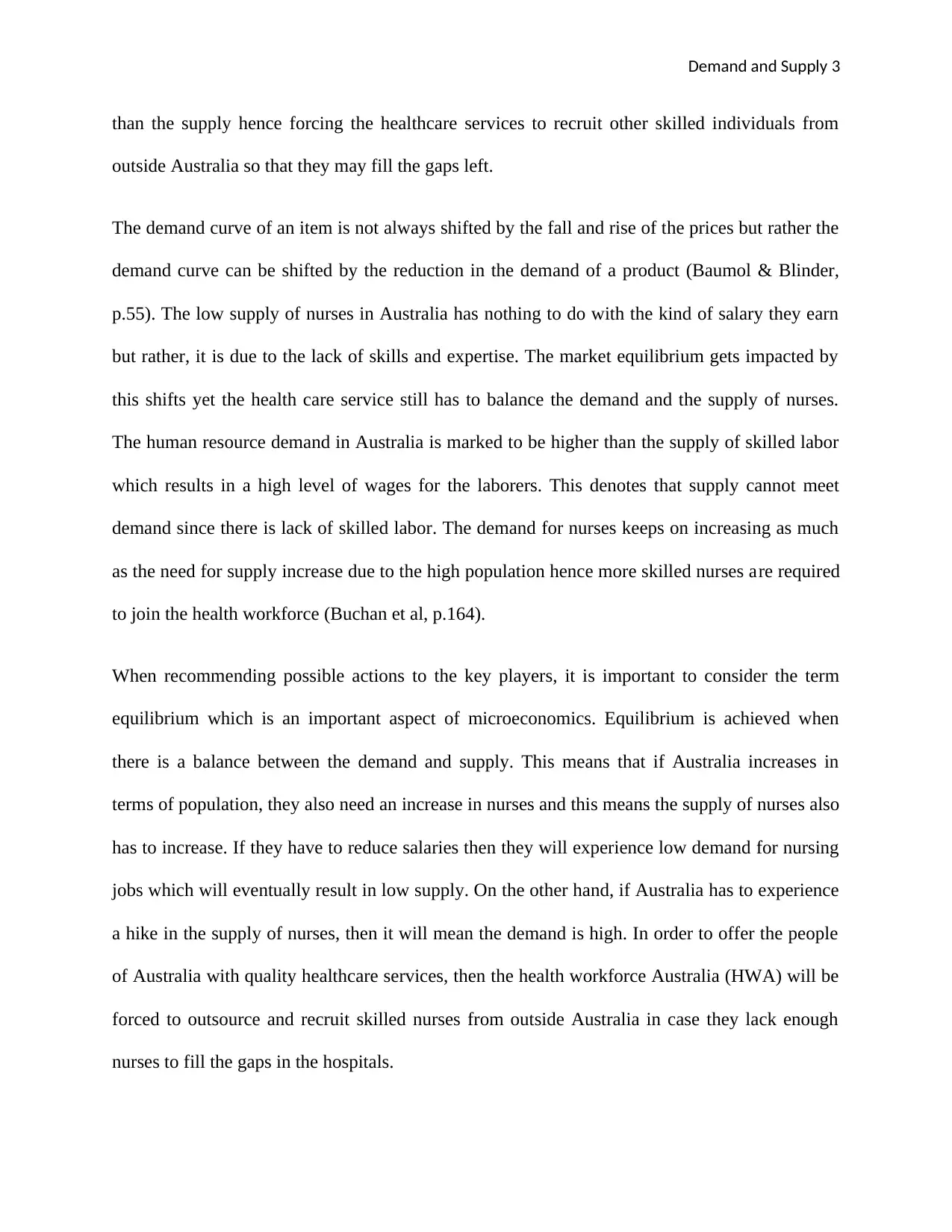
Demand and Supply 3
than the supply hence forcing the healthcare services to recruit other skilled individuals from
outside Australia so that they may fill the gaps left.
The demand curve of an item is not always shifted by the fall and rise of the prices but rather the
demand curve can be shifted by the reduction in the demand of a product (Baumol & Blinder,
p.55). The low supply of nurses in Australia has nothing to do with the kind of salary they earn
but rather, it is due to the lack of skills and expertise. The market equilibrium gets impacted by
this shifts yet the health care service still has to balance the demand and the supply of nurses.
The human resource demand in Australia is marked to be higher than the supply of skilled labor
which results in a high level of wages for the laborers. This denotes that supply cannot meet
demand since there is lack of skilled labor. The demand for nurses keeps on increasing as much
as the need for supply increase due to the high population hence more skilled nurses are required
to join the health workforce (Buchan et al, p.164).
When recommending possible actions to the key players, it is important to consider the term
equilibrium which is an important aspect of microeconomics. Equilibrium is achieved when
there is a balance between the demand and supply. This means that if Australia increases in
terms of population, they also need an increase in nurses and this means the supply of nurses also
has to increase. If they have to reduce salaries then they will experience low demand for nursing
jobs which will eventually result in low supply. On the other hand, if Australia has to experience
a hike in the supply of nurses, then it will mean the demand is high. In order to offer the people
of Australia with quality healthcare services, then the health workforce Australia (HWA) will be
forced to outsource and recruit skilled nurses from outside Australia in case they lack enough
nurses to fill the gaps in the hospitals.
than the supply hence forcing the healthcare services to recruit other skilled individuals from
outside Australia so that they may fill the gaps left.
The demand curve of an item is not always shifted by the fall and rise of the prices but rather the
demand curve can be shifted by the reduction in the demand of a product (Baumol & Blinder,
p.55). The low supply of nurses in Australia has nothing to do with the kind of salary they earn
but rather, it is due to the lack of skills and expertise. The market equilibrium gets impacted by
this shifts yet the health care service still has to balance the demand and the supply of nurses.
The human resource demand in Australia is marked to be higher than the supply of skilled labor
which results in a high level of wages for the laborers. This denotes that supply cannot meet
demand since there is lack of skilled labor. The demand for nurses keeps on increasing as much
as the need for supply increase due to the high population hence more skilled nurses are required
to join the health workforce (Buchan et al, p.164).
When recommending possible actions to the key players, it is important to consider the term
equilibrium which is an important aspect of microeconomics. Equilibrium is achieved when
there is a balance between the demand and supply. This means that if Australia increases in
terms of population, they also need an increase in nurses and this means the supply of nurses also
has to increase. If they have to reduce salaries then they will experience low demand for nursing
jobs which will eventually result in low supply. On the other hand, if Australia has to experience
a hike in the supply of nurses, then it will mean the demand is high. In order to offer the people
of Australia with quality healthcare services, then the health workforce Australia (HWA) will be
forced to outsource and recruit skilled nurses from outside Australia in case they lack enough
nurses to fill the gaps in the hospitals.
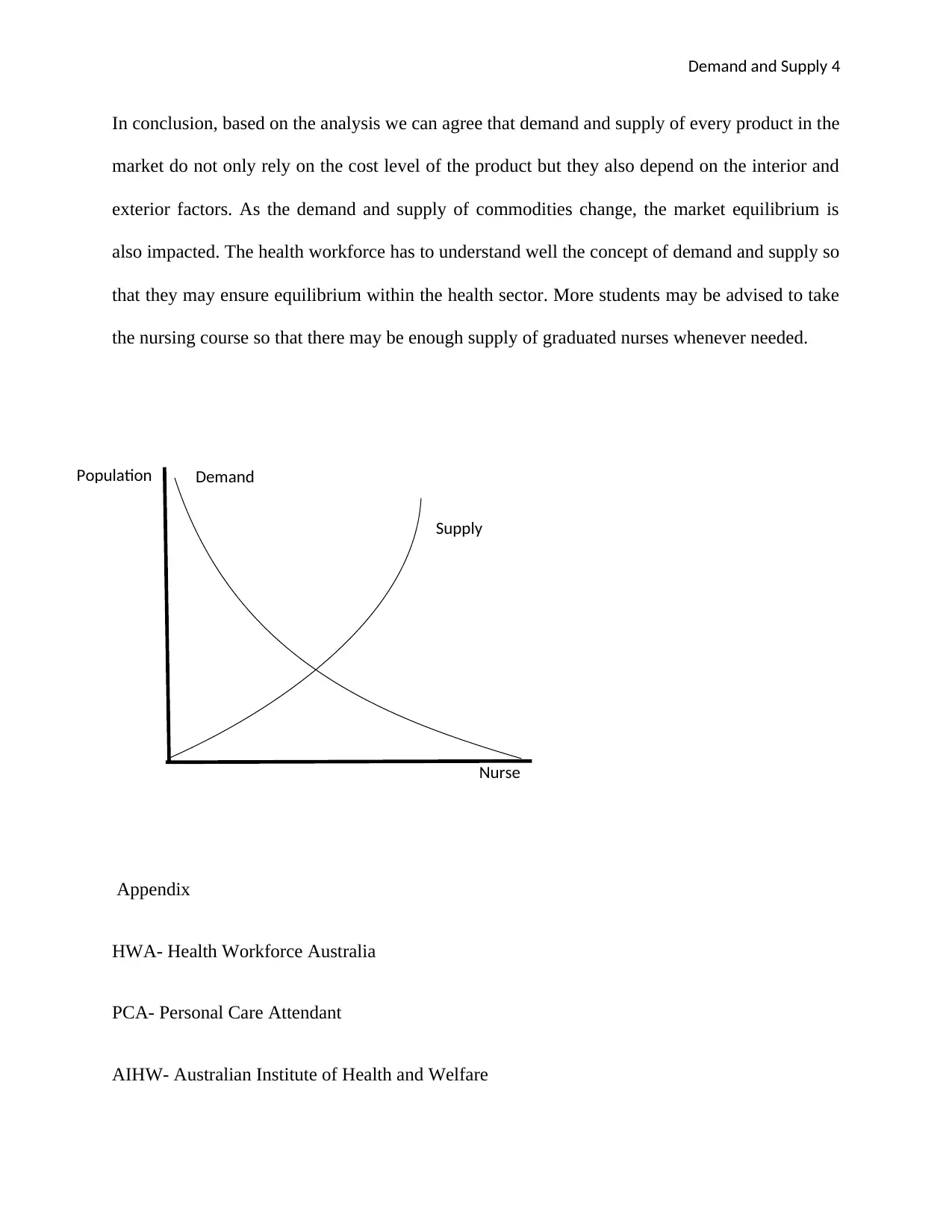
Demand and Supply 4
In conclusion, based on the analysis we can agree that demand and supply of every product in the
market do not only rely on the cost level of the product but they also depend on the interior and
exterior factors. As the demand and supply of commodities change, the market equilibrium is
also impacted. The health workforce has to understand well the concept of demand and supply so
that they may ensure equilibrium within the health sector. More students may be advised to take
the nursing course so that there may be enough supply of graduated nurses whenever needed.
Appendix
HWA- Health Workforce Australia
PCA- Personal Care Attendant
AIHW- Australian Institute of Health and Welfare
Population
Nurse
Demand
Supply
In conclusion, based on the analysis we can agree that demand and supply of every product in the
market do not only rely on the cost level of the product but they also depend on the interior and
exterior factors. As the demand and supply of commodities change, the market equilibrium is
also impacted. The health workforce has to understand well the concept of demand and supply so
that they may ensure equilibrium within the health sector. More students may be advised to take
the nursing course so that there may be enough supply of graduated nurses whenever needed.
Appendix
HWA- Health Workforce Australia
PCA- Personal Care Attendant
AIHW- Australian Institute of Health and Welfare
Population
Nurse
Demand
Supply
Secure Best Marks with AI Grader
Need help grading? Try our AI Grader for instant feedback on your assignments.
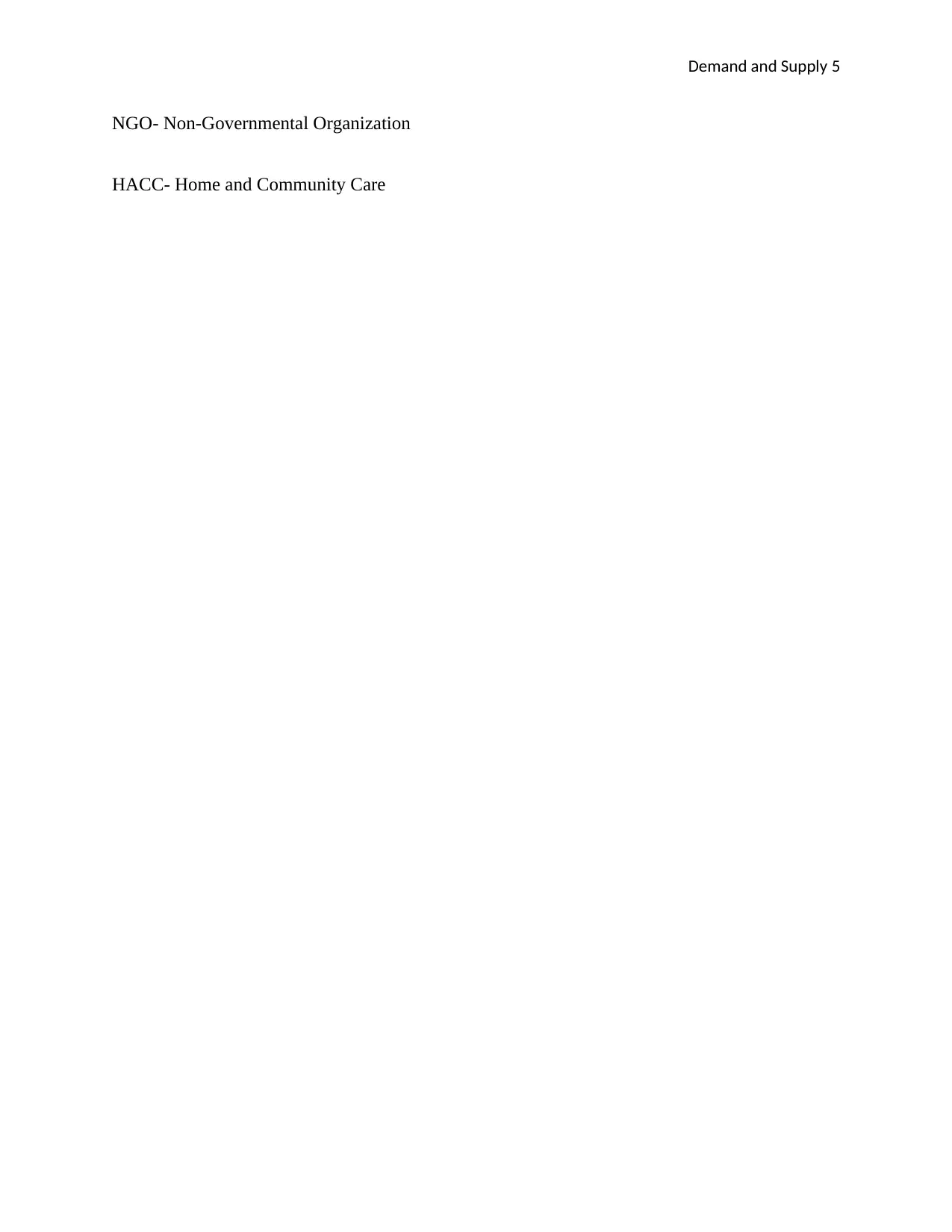
Demand and Supply 5
NGO- Non-Governmental Organization
HACC- Home and Community Care
NGO- Non-Governmental Organization
HACC- Home and Community Care
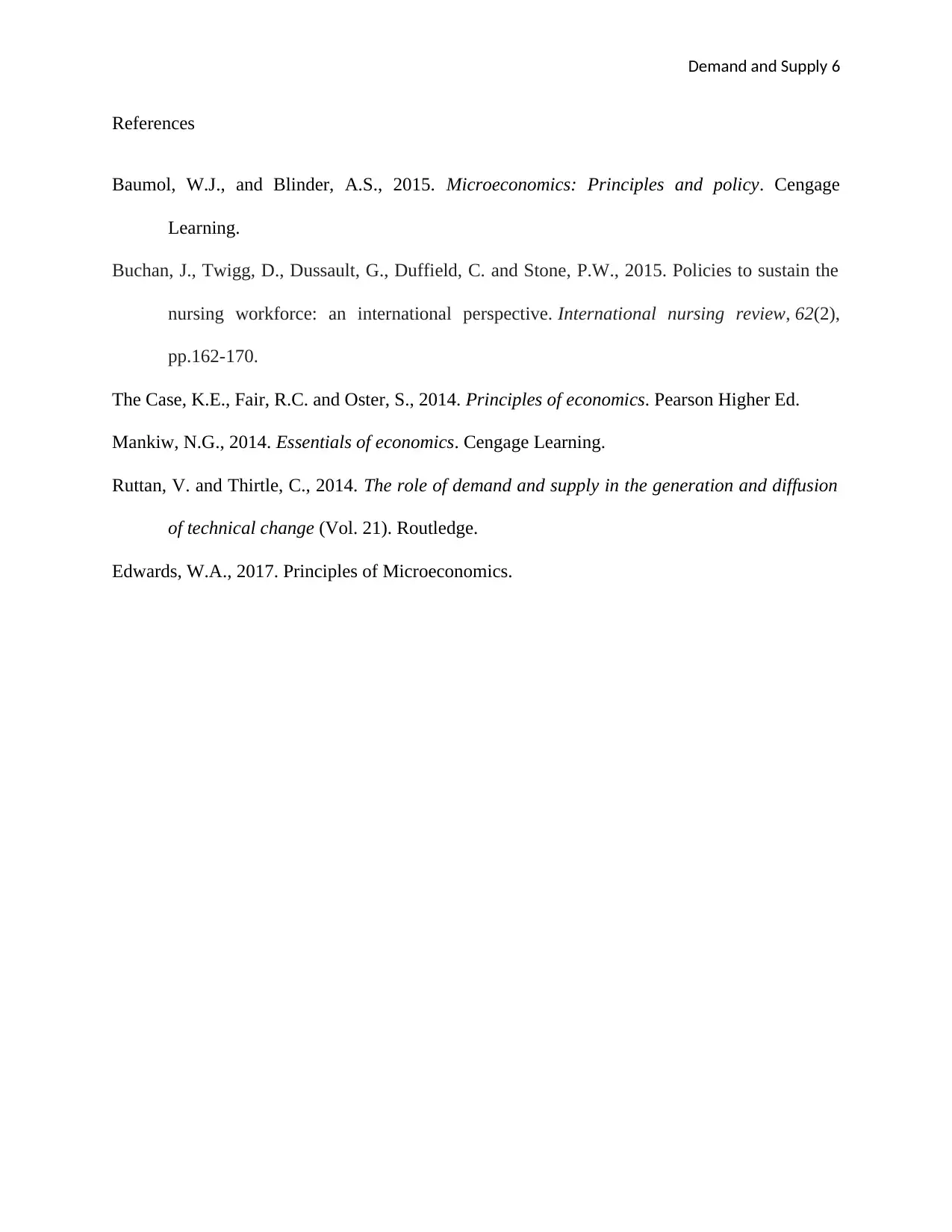
Demand and Supply 6
References
Baumol, W.J., and Blinder, A.S., 2015. Microeconomics: Principles and policy. Cengage
Learning.
Buchan, J., Twigg, D., Dussault, G., Duffield, C. and Stone, P.W., 2015. Policies to sustain the
nursing workforce: an international perspective. International nursing review, 62(2),
pp.162-170.
The Case, K.E., Fair, R.C. and Oster, S., 2014. Principles of economics. Pearson Higher Ed.
Mankiw, N.G., 2014. Essentials of economics. Cengage Learning.
Ruttan, V. and Thirtle, C., 2014. The role of demand and supply in the generation and diffusion
of technical change (Vol. 21). Routledge.
Edwards, W.A., 2017. Principles of Microeconomics.
References
Baumol, W.J., and Blinder, A.S., 2015. Microeconomics: Principles and policy. Cengage
Learning.
Buchan, J., Twigg, D., Dussault, G., Duffield, C. and Stone, P.W., 2015. Policies to sustain the
nursing workforce: an international perspective. International nursing review, 62(2),
pp.162-170.
The Case, K.E., Fair, R.C. and Oster, S., 2014. Principles of economics. Pearson Higher Ed.
Mankiw, N.G., 2014. Essentials of economics. Cengage Learning.
Ruttan, V. and Thirtle, C., 2014. The role of demand and supply in the generation and diffusion
of technical change (Vol. 21). Routledge.
Edwards, W.A., 2017. Principles of Microeconomics.
1 out of 6
Related Documents
Your All-in-One AI-Powered Toolkit for Academic Success.
+13062052269
info@desklib.com
Available 24*7 on WhatsApp / Email
![[object Object]](/_next/static/media/star-bottom.7253800d.svg)
Unlock your academic potential
© 2024 | Zucol Services PVT LTD | All rights reserved.




